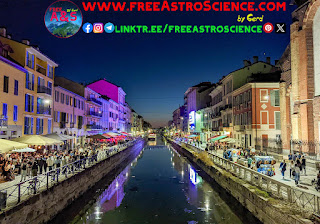In our modern world, electricity is the invisible force that powers our daily lives, driving innovation and sustaining our complex societal structures. At FreeAstroScience.com, we are committed to demystifying the wonders of science and technology, and today we delve into the essence of electricity. It's a phenomenon that, despite its omnipresence, remains somewhat of an enigma to the average person. Understanding the intricate dance of electrons that lights up our world is not just fascinating—it's essential. So let's embark on an electrifying journey to uncover the significance of electricity and imagine a world where this vital energy source suddenly vanishes.
Electricity: Humanity's Modern Cornerstone
Without electricity, imagine our civilization being thrust into a bygone era, reminiscent of the early 19th century—a time when the comforts and conveniences we now take for granted were unfathomable. Electricity has undeniably become a bedrock of contemporary society, yet its true essence often eludes the grasp of many.
Understanding Electricity: A Challenge for Many
The core concepts of electricity are grounded in scientific terms such as "electrons," "flow," "charge," and "current." Despite its critical role, the intricate processes within power plants, transformers, and transmission lines are understood by a mere fraction of the population. For most, the act of flipping a switch to illuminate a room or baking a pizza in an oven is a simple gesture, with little thought given to the complex journey electricity takes to reach that point.
Electricity Generation: Harnessing Energy from Various Sources
Electricity is a secondary energy source, meticulously crafted from primary energy sources by electric generators. The transformation involves a diverse array of sources, including the chemical energy in fossil fuels and biomass, nuclear reactions, the force of moving water, the power of the wind, the warmth of the sun, and the heat from Earth's geothermal reservoirs. Once created, this versatile energy is introduced into the power grid, journeying through a network of power lines to its final destination: the end user.
The Intricacies of Distribution and Storage
Distributing electricity is a logistical marvel, requiring the seamless transition from production sites to the bustling hubs of cities, factories, and electric transit systems. An intricate matrix of transformers and high-voltage lines, followed by a lower voltage distribution network of overhead and underground cables, ensures the flow of electricity to countless users. Yet, even with today's advancements, the perfect solution for large-scale electricity storage eludes us. Current technology cannot sustain the power needs of a metropolis for even a short period, making this one of the most pressing challenges in the energy sector.
The Centrality of Electricity in a Modern World
Electricity's ease of use, epitomized by the simple flip of a switch or a voice command, has long secured its dominance in public and private lighting, effectively conquering the night. Energy efficiency serves as a testament to electricity's triumph: consider that modern fluorescent lamps are about 500 times more efficient than candles, and sodium bulbs—often used in street lighting—are roughly 1,000 times more so.
Motors and lamps, two key applications of electricity, have revolutionized our world, making us reliant on this omnipotent energy source. From elevating our cities to powering the internet and mobile phones, electricity is the lifeblood of modern civilization.
The Hypothetical Blackout: A World Without Electricity
To gauge our dependency on electricity, let's consider a hypothetical scenario—a month-long blackout. The cessation of electric power would paralyze elevators, air conditioning systems, doors, waste compactors, hospital machinery, and even our cherished internet. Rail transportation, streetcars, and modern automobiles would screech to a halt, their electric motors silenced. Homes would be devoid of not just lighting but also heating, refrigeration, and all manner of electronic devices.
In such a scenario, the repercussions would be dire, especially in densely populated cities. The absence of public lighting would shroud our streets in an impenetrable darkness, and traffic systems would collapse. The spoilage of food supplies would ignite a crisis, and the inability to preserve basic necessities would exacerbate the chaos. A mere month without electricity could lead to a catastrophe surpassing the toll of recent global events, highlighting our profound dependence on this critical energy source.
At FreeAstroScience.com, we understand the complexity and significance of electricity in forging the world as we know it. As we unravel the marvels of science, we invite you to join us in appreciating the intricate web of energy that powers our lives and to ponder the remarkable journey electricity takes to keep our world alight.


Post a Comment